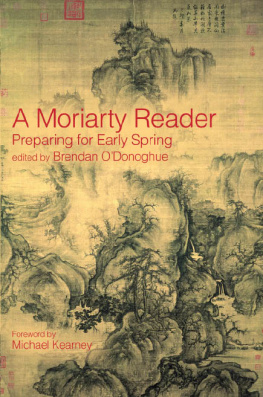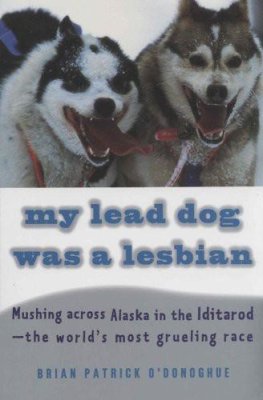ODonoghue - Outdoor
Here you can read online ODonoghue - Outdoor full text of the book (entire story) in english for free. Download pdf and epub, get meaning, cover and reviews about this ebook. year: 2010;2008, publisher: Hardie Grant Books, genre: Home and family. Description of the work, (preface) as well as reviews are available. Best literature library LitArk.com created for fans of good reading and offers a wide selection of genres:
Romance novel
Science fiction
Adventure
Detective
Science
History
Home and family
Prose
Art
Politics
Computer
Non-fiction
Religion
Business
Children
Humor
Choose a favorite category and find really read worthwhile books. Enjoy immersion in the world of imagination, feel the emotions of the characters or learn something new for yourself, make an fascinating discovery.
- Book:Outdoor
- Author:
- Publisher:Hardie Grant Books
- Genre:
- Year:2010;2008
- Rating:5 / 5
- Favourites:Add to favourites
- Your mark:
- 100
- 1
- 2
- 3
- 4
- 5
Outdoor: summary, description and annotation
We offer to read an annotation, description, summary or preface (depends on what the author of the book "Outdoor" wrote himself). If you haven't found the necessary information about the book — write in the comments, we will try to find it.
Outdoor — read online for free the complete book (whole text) full work
Below is the text of the book, divided by pages. System saving the place of the last page read, allows you to conveniently read the book "Outdoor" online for free, without having to search again every time where you left off. Put a bookmark, and you can go to the page where you finished reading at any time.
Font size:
Interval:
Bookmark:

OUTDOOR
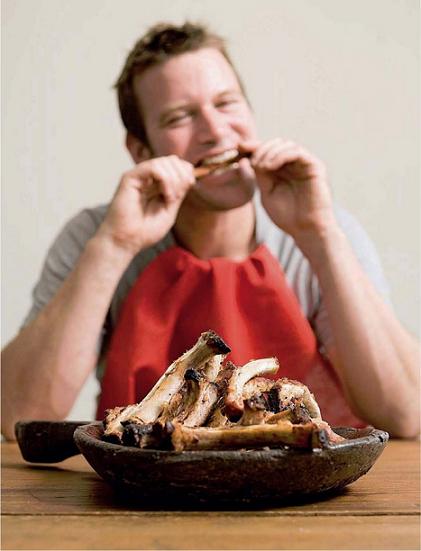
When our Neolithic forebears used fire to protect themselves from the wild beasts of the world, I wonder if they had any idea as they were twirling hairy morsels of some prehistoric animal at the end of a stick to consume, in many thousands of years time people around the world would still be using their techniques to cook slightly more appetising things to eat in their backyards.
For most people, a barbecue is all about meat duck, chicken, rabbit, cow, pork. I reckon the latter was given to us by God for the sole purpose of barbecuing, it tastes soooo good. Just try Chinese char sui, a Mexican pit barbacoa or ribs and pulled pork from the American south, and youll see what I mean. Then theres Thai chicken and African/Portuguese peri-peri chicken. And how can we forget the wonderful flavours of the perfect grilled steak, the famous bistecca alla fiorentina and the one-day-to-cook Texas beef brisket?
Cooking techniques differ from country to country, and can involve smoking and slow cooking or the fierce direct heat of a coal fire. The asado and churrasco methods of barbecuing meat are perfect examples of direct grilling. These South American styles were created in countries that grew up on the fat of the land and the back of a cow!
Argentinean asado
In the early part of the twentieth century, Argentina produced grain and beef of the highest quality, so its not too much of a surprise that Argentineans continue to consume a lot of meat.
An asado is a very popular, traditional method of cooking meat, originating in the Pampas regions of Argentina, Uruguay, Chile and Brazil. Typically, a wood fire burning on the ground or in a pit is surrounded by metal cross-stakes upon which the meat is rested, splayed open to receive the heat. The preparation is simple: the meat is merely seasoned with salt before and during the cooking process. Its a slow method of cooking, and the heat and the meats distance from the fire need to be controlled. The meat juices and fat are never allowed to hit the fire because the smoke will affect the flavour of the meat, and often the fire is cleared from underneath the meat during the proceedings. The meat is generally transferred to a tray and typically served with chimichurri, a herb dressing.
Meat served at an asado is eaten in the following sequence: morcillas (blood sausages), chorizos, chinchulines (intestines), mollejas (sweetbreads) and other organs, followed by the ribs and steaks. Food cooked la asado is when a parrilla (grill) is placed over coals that have formed from the fire and the meat is then cooked over the slow heat of the coals.
One of my kitchen porters used to reminisce about the asados back home in South America. They would build a big fire on the beach and skewer a whole strip loin on a star picket and then knock it into the ground next to the fire. As the fire burnt down they would move the star picket and the meat closer in until it was cooked. Now thats a barbecue!
South American churrasco
Churrasco is a Spanish/Portuguese word that defines the grilling of meat over a wood or coal fire. The definition varies across South America, from Central American countries such as Nicaragua, where it is used to describe long strips of tenderloin beef cooked on skewers and served with chimichurri, to Argentina, where it describes a large cut of beef that forms one of the courses cooked on an asado.
The true identity of the churrasco finds its origins in the southern regions of Brazil, where the Gauchos (cowboys) of the Pampas regions would cook their meat over coals on spikes, as opposed to the grills found in Argentina and Uruguay. This style of cooking found its way via highway eateries and truck stops to the large cities, where the cooking technique became more sophisticated. Typically, the meat is not marinated but simply seasoned with a paste of salt and water brushed onto the meat as it cooks. It really is flame-cooked meat at its purest!
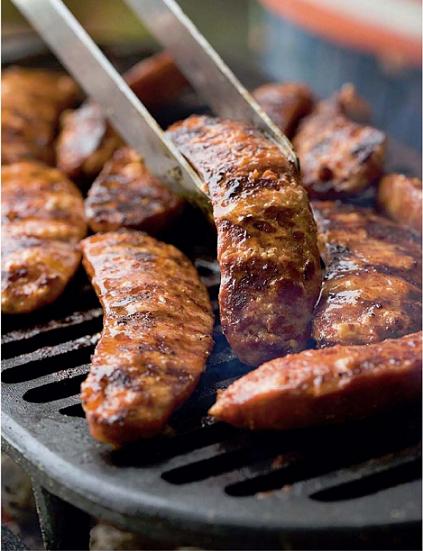
How to cook the perfect steak
Most barbecue lovers are meat junkies, so it stands to reason that most barbecues involve cooking the odd steak. I know there are some criminal meat cooks out there, as I have witnessed some major acts of steak slaughter.
Follow these simple steps and youre guaranteed to end up with the perfect steak every time. Its worth remembering though that the quality of the meat is a huge factor in the tenderness and tastiness of the end product.
The selection of the right cut is important. Youre going to need a cut that is tender. The cuts that are best suited to the high heat of direct grilling are of course a well-marinated skirt steak or cuts such as sirloin, porterhouse, T-bone, rump or tenderloin (fillet). All these cuts have a broad surface area that takes advantage of the charred flavour from the high heat.
I recommend that the steaks be allowed to return to room temperature prior to grilling. This not only makes the cooking time shorter but also means that you lose less moisture from your meat.
Season your steaks just prior to grilling with coarsely ground rock salt or quality crystal salt and freshly ground pepper, or with spices if thats what youre using. If added early on, salt will draw moisture from the protein of the meat, which will in turn dissolve the salt. The coarse salt helps to protect the meat from sticking to the grill and also gives a lovely crust to the meat.
Your fire should be built or the gas arranged so you have a hot area and a cooler area so you can move your steak from the high heat to a more steady, lower heat. This is more important if youre cooking large, thick steaks as opposed to thin, quick-cook steaks. Be sure that your grill is clean and free of oil and fat, as they will impart a tainted flavour to your grilled meat. I never oil the steaks or the grill as oil cooking over a high heat will burn and flavour the meat. A hot fire and some seasoning are all you need to stop the steak from sticking.
Now its time to cook your steaks. The golden rule is to never overcrowd your grill, as too many steaks will absorb the heat and lower the cooking temperature of the grill, especially if youre cooking on gas. Arrange your steaks in a row, in the order in which you plan to cook them. Organisation is the key to grill control.
Allow your steak to seal on the first side for 23 minutes, then rotate it 90 degrees so you end up with crisscross grill marks for presentation. You should only turn steaks a maximum of three times (this was something I was taught from a young age as a grill chef). Moisture from the steak will push up through the meat away from the heat. The trick is to create a balance between the two sides of the meat. Heat seals the meat surface, reducing the moistures chance of escaping. If you allow the steak to remain on one side for too long, all the moisture will push out the other side and you will have a dry steak.
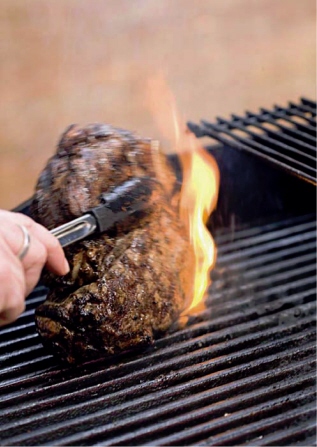
As a general rule, when cooking inch-thick steaks turn them after about 5 minutes and repeat the crisscross cooking on the other side. You will require a little less time on the second side, as the meat will be hotter; allow 34 minutes. Give the meat a final turn for just 30 seconds, just to heat the other side once again and to balance the movement of moisture.
Next pageFont size:
Interval:
Bookmark:
Similar books «Outdoor»
Look at similar books to Outdoor. We have selected literature similar in name and meaning in the hope of providing readers with more options to find new, interesting, not yet read works.
Discussion, reviews of the book Outdoor and just readers' own opinions. Leave your comments, write what you think about the work, its meaning or the main characters. Specify what exactly you liked and what you didn't like, and why you think so.


